A General Analytical Solution for Two-Dimensional Columnar Crystal Growth during Laser Beam Welding of Thin Steel Sheets
Abstract
1. Introduction
2. Materials and Methods
- The dimensions of the weld pool boundary change only to a minor extent along the thickness, which is the case when welding thin plates in complete penetration keyhole mode. Thus, the crystallization problem becomes two-dimensional, i.e., the crystals do not grow in the thickness direction.
- The crystallization process reaches a steady state, i.e., the shape and size of the weld pool boundary do not vary with time.
- The weld pool boundary is not affected by the increasing impurity concentration ahead of the solid–liquid interface. Furthermore, the boundary is defined by the isosurface of the liquidus temperature, .
- The weld pool boundary, obtained experimentally or from a thermo-fluid dynamics simulation, is mathematically reconstructed with Lamé curves according to [15].
- The formation of substructures, e.g., planar, cellular, or dendritic, inside the crystals is not taken into account as it has a rather insignificant effect on the macroscopic crystal structure in polycrystalline materials [2].
- The crystallographic orientation and competitive growth are neglected as their consideration would significantly complicate the task [7,16]. As a consequence, the crystal is assumed to grow along the temperature gradient which coincides with the inward normal direction to the crystallization front [4,7,8,9].
3. Results
3.1. Experimental Validation
3.2. Dimensionless Analysis
4. Conclusions
- The Lamé curves approximation was successfully utilized for the reconstruction of the rear weld pool boundary and thus for the analysis of the crystallization parameters. It was shown that the reconstruction of the weld pool boundary with Lamé curves provides higher accuracy and flexibility compared to results obtained with elliptical functions.
- General analytical expressions for the main solidification parameters, namely the crystal axis and the corresponding growth rate and cross-sectional area of the crystal were derived.
- Dimensionless analysis of the influence of the size and shape of the rear weld pool boundary on the crystallization parameters was provided. It was shown that sharpened rear weld pool boundaries lead to a higher solidification rate and vice versa. Thus, critical welding parameters can be estimated and adapted accordingly to improve the welding process.
- The derived equations and herewith obtained results were validated and verified by comparing them to known theoretical solutions and experimental measurements, showing a very good correlation.
Author Contributions
Funding
Conflicts of Interest
References
- Messler, R.W., Jr. Principles of Welding; Processes, Physics, Chemistry, and Metallurgy; John Willey & Sons. Inc.: New York, NY, USA, 1999. [Google Scholar]
- Kou, S. Welding Metallurgy; John Wiley & Sons, Inc.: Hoboken, NJ, USA, 2002. [Google Scholar]
- Rayamyaki, P.; Karkhin, V.; Khomich, P. Determination of the main characteristics of the temperature field for the evaluation of the type of solidification of weld metal in fusion welding. Weld. Int. 2007, 21, 600–603. [Google Scholar] [CrossRef]
- Prokhorov, N.N. Physical Processes in Metals during Welding. Volume 1: Elements of Physics of Metals and Solidification Process; Metallurgiya: Moscow, Russia, 1968. [Google Scholar]
- Prokhorov, N.N. Technological Strength of Welds during Crystallisation; Metallurgiya: Moscow, Russia, 1979. [Google Scholar]
- Karkhin, V.A.; Ivanov, S.Y.; Homich, P.N.; Rajamaki, P. Analysis of solute macro-and microsegregation in fusion welding. In Mathematical Modeling of Weld Phenomena; Verlag der Technischen Universitaet Graz: Graz, Austria, 2010; Volume 9. [Google Scholar]
- Ploshikhin, V.V.; Bergmann, H.W. Simulation of grain structures in laser beam welds undergoing the planar solidification mode. Numer. Anal. Weldabil. 1997, 150–165. [Google Scholar]
- Karkhin, V.A. Thermal Processes in Welding; Springer: Singapore, 2019; Volume 478. [Google Scholar]
- Glicksman, M.E. Principles of Solidification: An Introduction to Modern Casting and Crystal Growth Concepts; Springer Science & Business Media: Luxemburg, 2010. [Google Scholar]
- Wei, H.L.; Elmer, J.W.; DebRoy, T. Origin of grain orientation during solidification of an aluminum alloy. Acta Mater. 2016, 115, 123–131. [Google Scholar] [CrossRef]
- Draxler, J.; Edberg, J.; Andersson, J.; Lindgren, L.E. Modeling and simulation of weld solidification cracking part II. Weld. World 2019, 63, 1503–1519. [Google Scholar] [CrossRef]
- Artinov, A.; Meng, X.; Bachmann, M.; Rethmeier, M. Numerical analysis of the partial penetration high power laser beam welding of thick sheets at high process speeds. Metals 2021, 11, 1319. [Google Scholar] [CrossRef]
- Artinov, A.; Meng, X.; Bachmann, M.; Rethmeier, M. Study on the transition behavior of the bulging effect during deep penetration laser beam welding. Int. J. Heat Mass Transf. 2022, 184, 122171. [Google Scholar] [CrossRef]
- Artinov, A.; Bachmann, M.; Meng, X.; Karkhin, V.; Rethmeier, M. On the relationship between the bulge effect and the hot cracking formation during deep penetration laser beam welding. Procedia CIRP 2020, 94, 5–10. [Google Scholar] [CrossRef]
- Artinov, A.; Karkhin, V.; Bakir, N.; Meng, X.; Bachmann, M.; Gumenyuk, A.; Rethmeier, M. Lamé curve approximation for the assessment of the 3D temperature distribution in keyhole mode welding processes. J. Laser Appl. 2020, 32, 022042. [Google Scholar] [CrossRef]
- Karkhin, V.A.; Ploshikhin, V.V.; Bergmann, H.W. Solution of inverse heat conduction problem for determining heat input, weld shape, and grain structure during laser welding. Sci. Technol. Weld. Join. 2002, 7, 224–231. [Google Scholar] [CrossRef]
- Olshanskaya, T.V. Theoretical and Technological Bases of Forming Welded Joints of Alloy Steels by Electron Beam Welding with Beam Sweeping. Ph.D. Dissertation, PERM National Research Polytechnic University, 2018. [Google Scholar]
- Korn, G.A.; Korn, T.M. Mathematical Handbook for Scientists and Engineers: Definitions, Theorems, and Formulas for Reference and Review; Courier Corporation: North Chelmsford, MA, USA, 2000. [Google Scholar]
- Wolfram Research. Hypergeometric Function; Wolfram Research, Inc.: Champaign, IL, USA, 1999. [Google Scholar]
- EN 10088-3:2014; Stainless Steels—Part 3: Technical Delivery Conditions for Semi-Finished Products, Bars, Rods, Wire, Sections and Bright Products of Corrosion Resisting Steels for General Purposes. DIN: Berlin, Germany, 2014.
- ISO/TS 18166:2016; Numerical Welding Simulation—Execution and Documentation. ISO: Geneva, Switzerland, 2016.
- Artinov, A.; Karkhin, V.; Bachmann, M.; Rethmeier, M. Mathematical modeling of the geometrical differences between the weld end crater and the steady-state weld pool. J. Laser Appl. 2020, 32, 022024. [Google Scholar] [CrossRef]
- Weck, E.; Leistner, E. Metallographic Instructions for Colour Etching by Immersion, Part III: Non-Ferrous Metals, Cemented Carbides and Ferrous Metals, Nickel-Base and Cobalt-Base Alloys; DVS GmbH: Dusseldorf, Germany, 1986. [Google Scholar]
- Artinov, A.; Bachmann, M.; Rethmeier, M. Equivalent heat source approach in a 3D transient heat transfer simulation of full-penetration high power laser beam welding of thick metal plates. Int. J. Heat Mass Transf. 2018, 122, 1003–1013. [Google Scholar] [CrossRef]
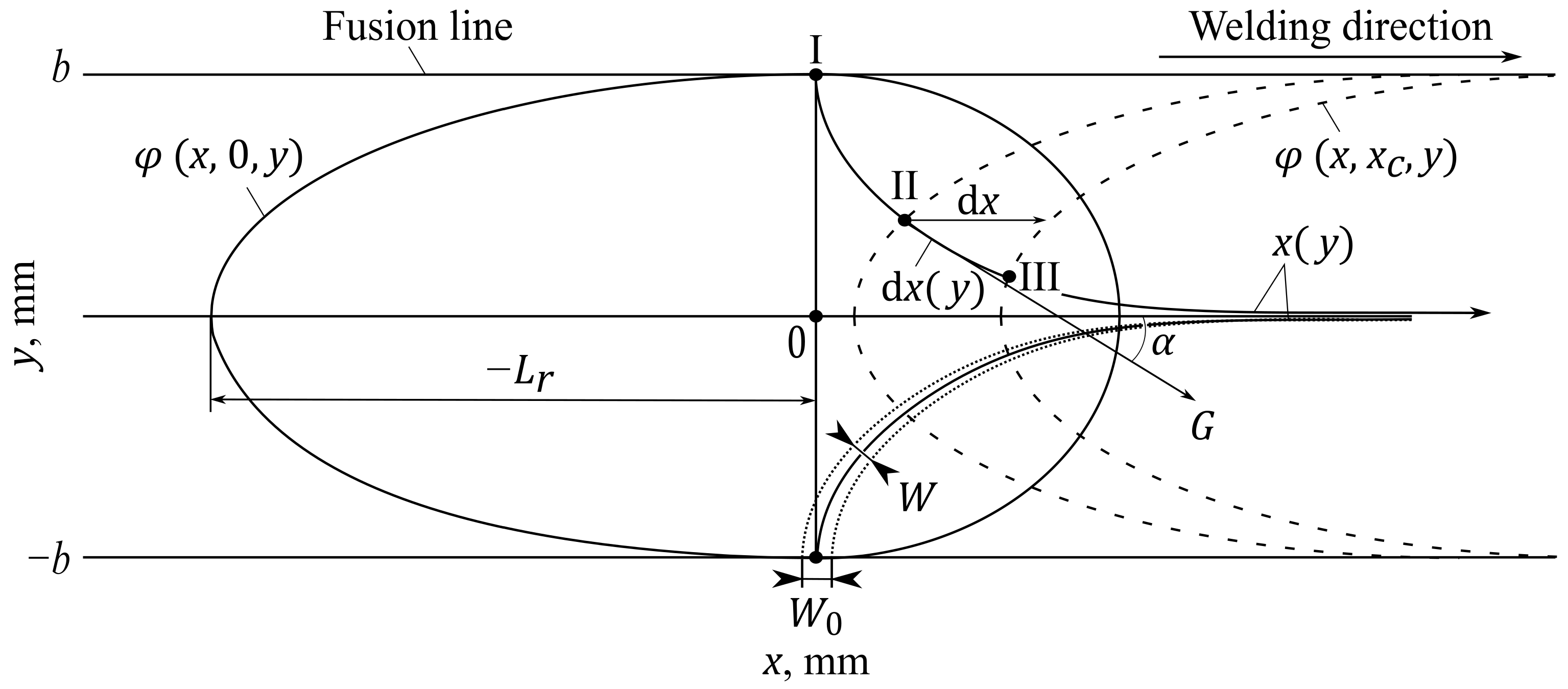
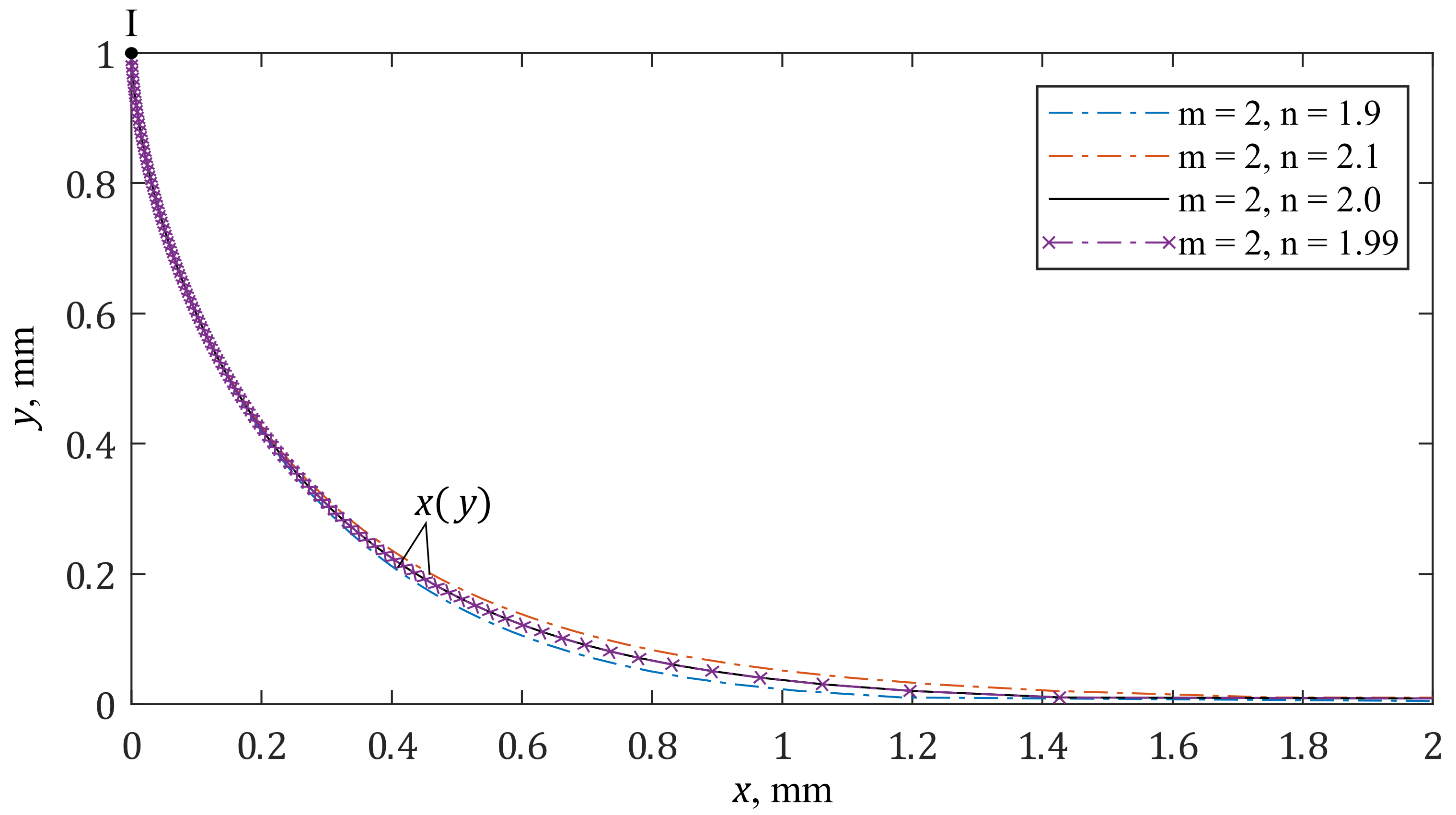
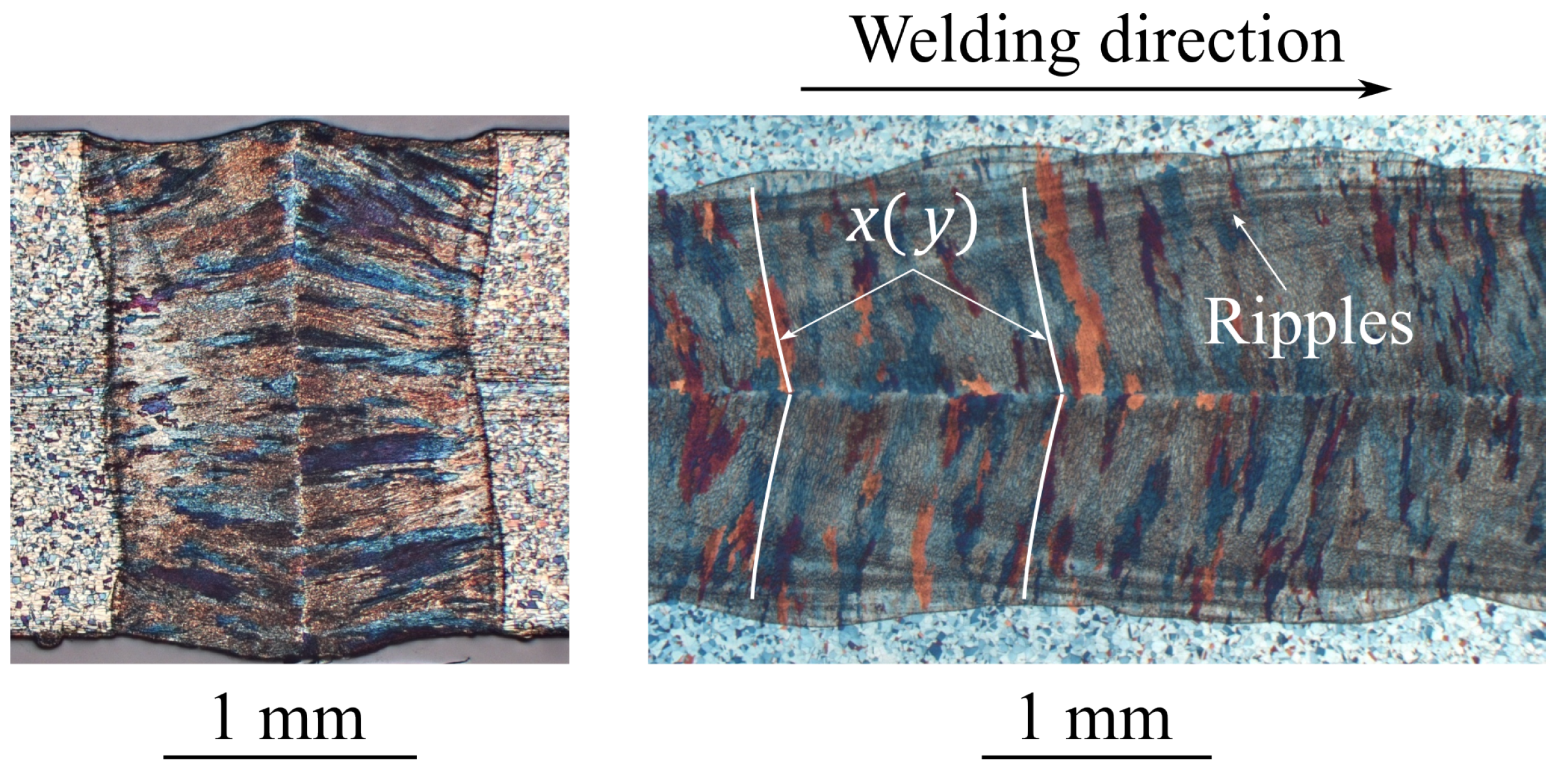
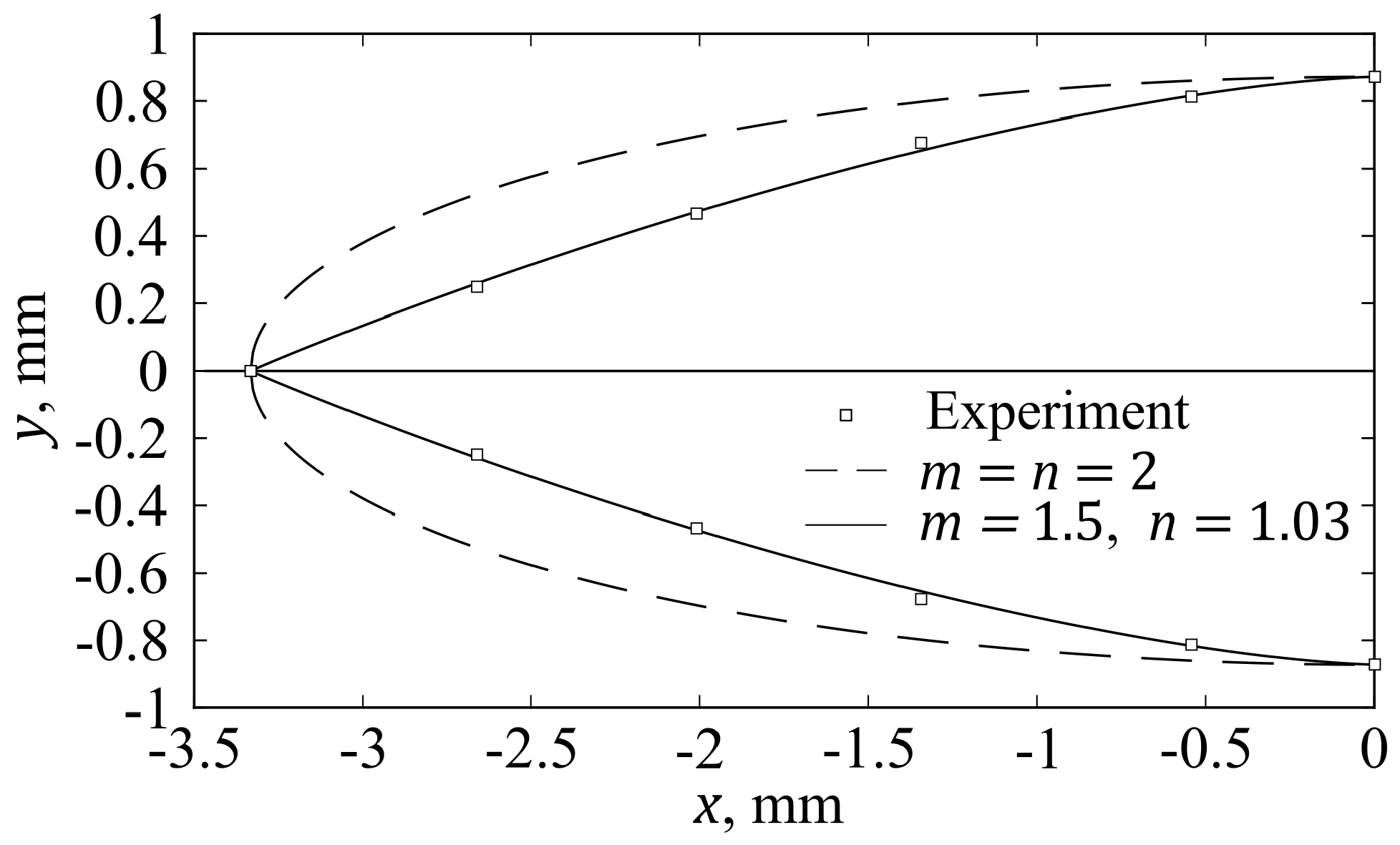
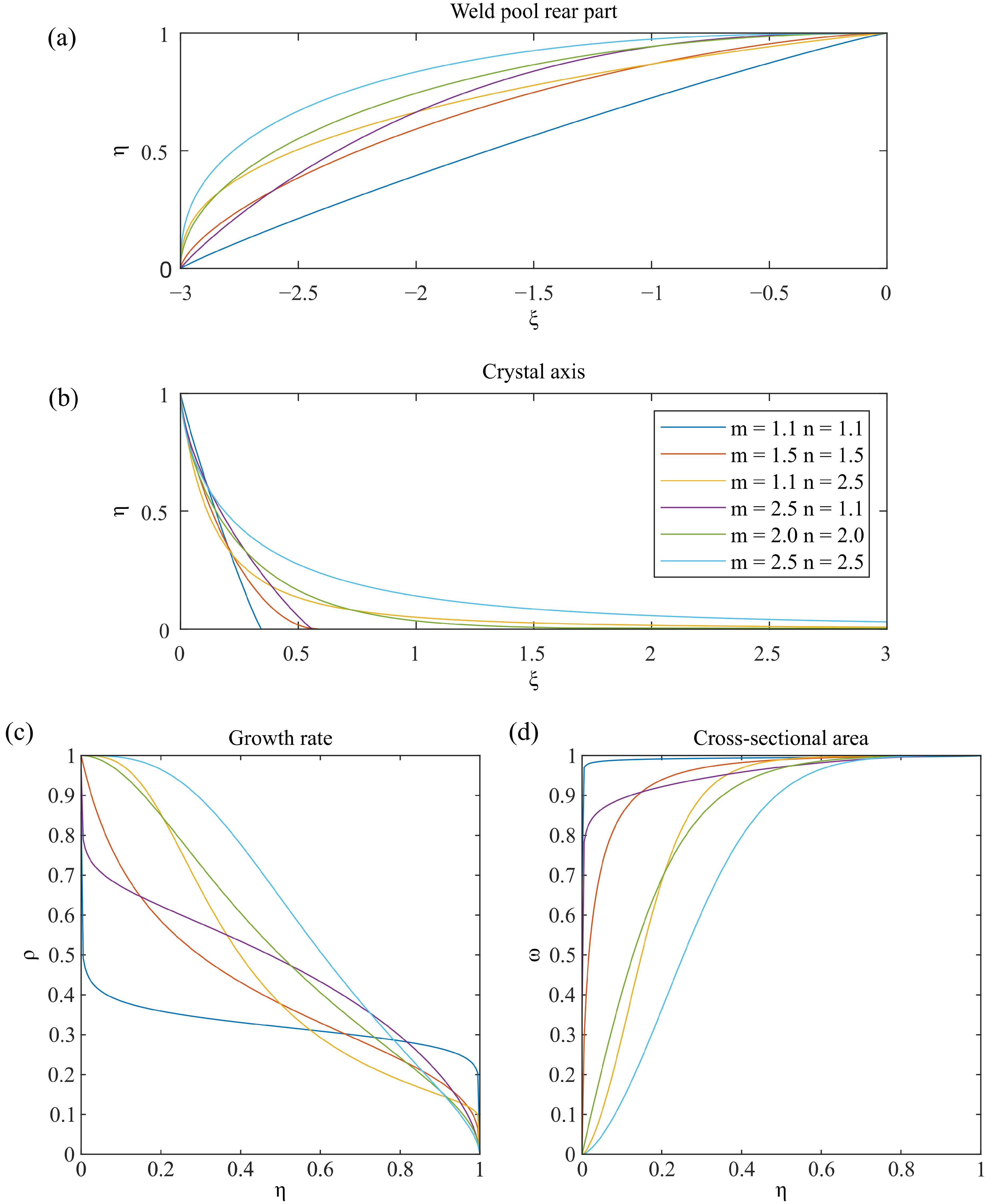
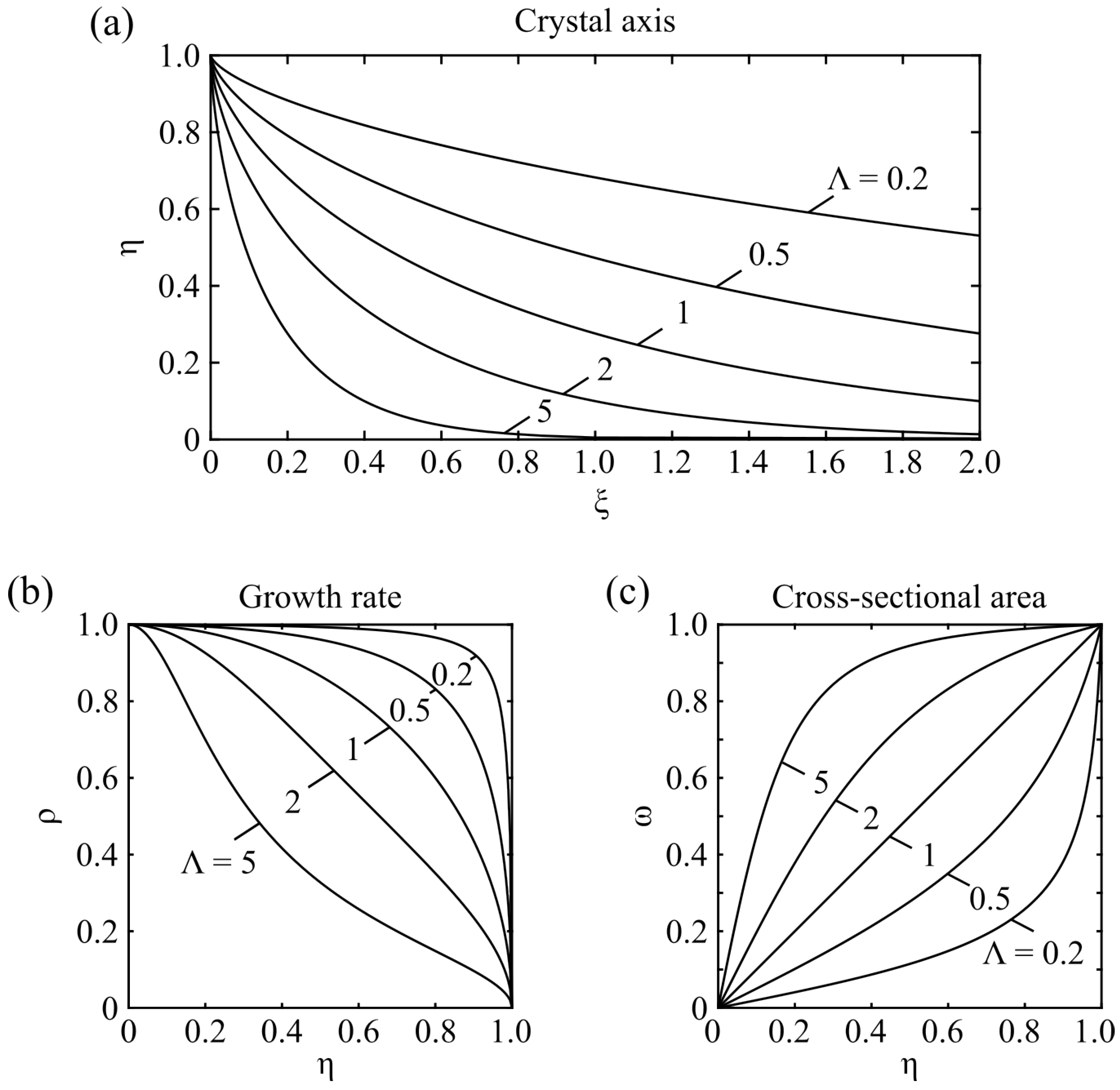
| C | Cr | Ni | Fe | |
|---|---|---|---|---|
| DIN EN 10088-3 | ≤0.03 | 16.5−18.5 | 10.0−13.0 | bal. |
| Measured | 0.03 | 16.95 | 10.57 | bal. |
Disclaimer/Publisher’s Note: The statements, opinions and data contained in all publications are solely those of the individual author(s) and contributor(s) and not of MDPI and/or the editor(s). MDPI and/or the editor(s) disclaim responsibility for any injury to people or property resulting from any ideas, methods, instructions or products referred to in the content. |
© 2023 by the authors. Licensee MDPI, Basel, Switzerland. This article is an open access article distributed under the terms and conditions of the Creative Commons Attribution (CC BY) license (https://creativecommons.org/licenses/by/4.0/).
Share and Cite
Artinov, A.; Karkhin, V.; Meng, X.; Bachmann, M.; Rethmeier, M. A General Analytical Solution for Two-Dimensional Columnar Crystal Growth during Laser Beam Welding of Thin Steel Sheets. Appl. Sci. 2023, 13, 6249. https://doi.org/10.3390/app13106249
Artinov A, Karkhin V, Meng X, Bachmann M, Rethmeier M. A General Analytical Solution for Two-Dimensional Columnar Crystal Growth during Laser Beam Welding of Thin Steel Sheets. Applied Sciences. 2023; 13(10):6249. https://doi.org/10.3390/app13106249
Chicago/Turabian StyleArtinov, Antoni, Victor Karkhin, Xiangmeng Meng, Marcel Bachmann, and Michael Rethmeier. 2023. "A General Analytical Solution for Two-Dimensional Columnar Crystal Growth during Laser Beam Welding of Thin Steel Sheets" Applied Sciences 13, no. 10: 6249. https://doi.org/10.3390/app13106249
APA StyleArtinov, A., Karkhin, V., Meng, X., Bachmann, M., & Rethmeier, M. (2023). A General Analytical Solution for Two-Dimensional Columnar Crystal Growth during Laser Beam Welding of Thin Steel Sheets. Applied Sciences, 13(10), 6249. https://doi.org/10.3390/app13106249








